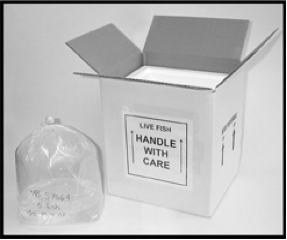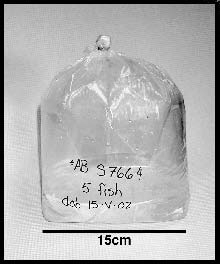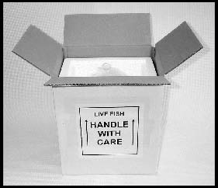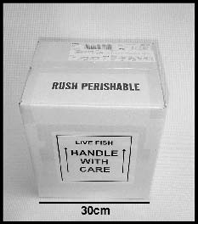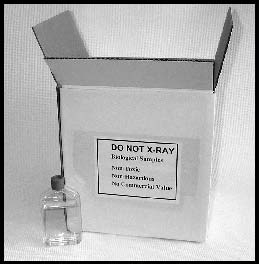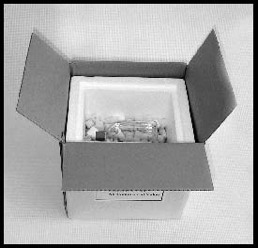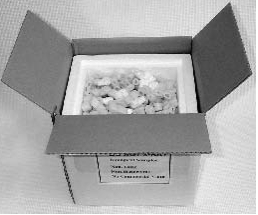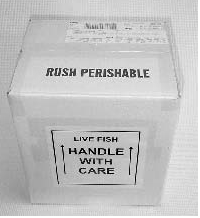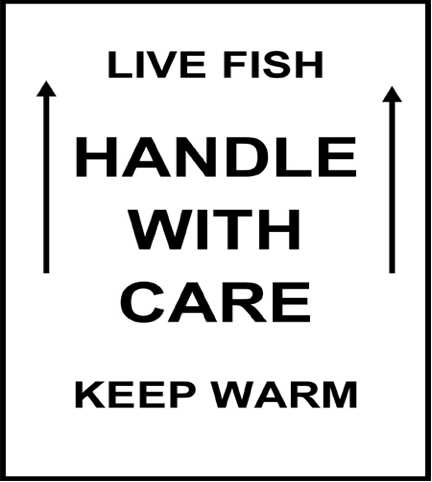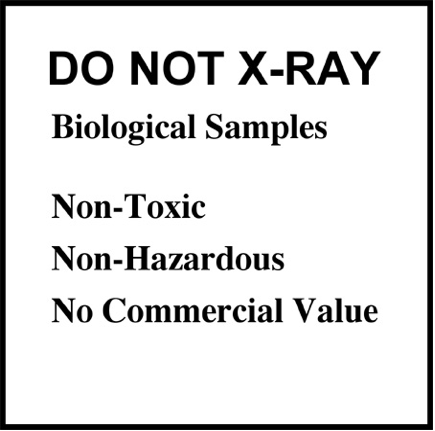Shipping Fish
(Source: J. McAuley from Zebrafish Book 5th Edition)
Time Deadlines Shipments should be timed to arrive as quickly as possible, avoiding weekend and holiday delays. International shipments should be sent out on Monday or Friday. This allows time for the fish to wait in Customs.
Supplies Needed - Boxes for shipping - a Styrofoam box nested inside a cardboard box- Plastic bags for shipping adult fish - should hold approximately 3L- 250ml tissue culture flasks for shipping babies- Methylene blue- Clear packing tape and rubber bands- Labels: live fish stickers (at the end of this document) and Federal Express (or other courier) address labels- Styrofoam packing peanuts - do not use peanuts that dissolve in contact with water
Protocol for Shipping Adult Fish
1. Ship adult fish in water filled plastic bags, five fish per bag.
2. Write information about the fish on the plastic bag (genotype, how many of each sex, how old, etc).
3. Fill bag 1/3 full with fish water. Add fish.
4. To include as much air as possible, arrange the water filled bag to be fully open. Grasp the top of the bag, closing it off and twisting. Twist well, keeping the pressure in the bag so that it looks like a cushion. Check the bag at this point to see that it is 2/3 air, 1/3 water. Do not blow into the bag to add more air, instead open the bag and capture more air. Alternatively, fill the bag with oxygen (if available).
5. Seal the bag either by knotting it or twisting the neck so that the twist doubles over. Secure rubber bands tightly around the knot. Push the closure down to maintain the pressure in the bag. You want the bag to remain tight.
6. Take the bottom points of the bag and tape them up along the sides of the bag, creating a square bottom. This prevents fish from being caught and injured in the corners. Tip the bag over to make sure it does not leak at the closure.
7. Place the bag into another plastic bag, double bagging it. Line the bags up with each other (by their seams) so that they are in the same orientation. Suck the air out of the second bag, so that if the inner bag leaks, there will be no place for the water to go. Close the outer bag by knotting and/or sealing with a rubber band.
8. Place the bagged fish in the Styrofoam box inside the cardboard box, and fill up any extra space with Styrofoam packing peanuts.
Details on Packing Adults for Shipment: Use two boxes nested inside each other to ship fish. The outside box is a cardboard box. The inside box is a thick Styrofoam box with a Styrofoam lid. The inside box is very important; it protects the fish from rapid temperature changes. The inside Styrofoam box fits the cardboard box perfectly, so it will not rattle around inside of the cardboard box. Note the shipping labels attached to the box. These are described below. The pictured box is available for purchase at: http://www.polyfoam.com | |
Ship adult fish in plastic bags at a density of approximately 5 fish per liter. Note that the double bag has remained tight, retaining its air pressure. This pressure is important because it helps insulate the fish. Also, note that the bag does not have pointed corners that may trap fish when set on a hard surface. This is achieved by grasping the point of the bag's corner, and taping it up against the wall of the bag. Do this for each of the bottom corners. | |
Place the double bag containing the adult fish inside the Styrofoam box. Fill any space around the bag with Styrofoam peanuts. Important: do not use packing peanuts that break down in water. Fill any remaining space with packing peanuts to insulate the fish and to prevent excessive movement during shipment. | |
~ ~Place the Styrofoam lid on the Styrofoam box and seal with tape. This inside lid helps insulate the fish. It also serves to prevent water from leaking out of the box if the bag springs a leak. Close the cardboard box and tape it shut with shipping tape. Apply tape to all of the seams of the box to help contain possible leaks. Attach the address label to the top of the box. For international shipments, also attach customs papers. |
Protocol for shipping babies
Fill a 250 ml tissue culture flask with 150 ml of sterile (autoclaved) fish system water.
Add 50 ml of diluted methylene blue (dilution: 2ml of 0.1% methylene blue, to 1 liter of fish water). At this concentration, methylene blue inhibits growth of mold in the water.
Add 100 embryos per flask. Preferably, send one day old fish. Flask should have air space and not be filled entirely with fluid. Close lid tightly.
It is very important to pack embryos for shipping in an insulated container. Zebrafish require warm temperatures for normal development, and these conditions need to be met during shipping as well.
Use two boxes nested inside each other to ship fish. The outside box is a cardboard box. The inside box is a thick Styrofoam box with a Styrofoam lid. The inside box is very important; it protects the fish from rapid temperature changes. The inside Styrofoam box fits the cardboard box perfectly, so it will not rattle around inside of the cardboard box. Note the shipping labels attached to the box. These are described below. The pictured box is available for purchase at: http://www.polyfoam.com | |
Fill the box half full with Styrofoam packing peanuts. Important: do not use packaging peanuts that breakdown in water. Place the tissue culture flask containing the embryos inside the Styrofoam box (ensure that the lid is firmly on and that no water leakage occurs). Push the tissue culture flask into the packaging peanuts. |
|
Fill the box completely with packaging peanuts, covering the flask completely. Fill up all space so that the flask will not move during shipping. Place the Styrofoam lid on the Styrofoam box and seal with tape. This inside lid helps insulate the fish. It also serves to prevent water from leaking out of the box if the bag springs a leak. | |
Close the cardboard box and tape shut with shipping tape. Apply tape to all of the seams of the box to help contain possible leaks. Attach the address label to the top of the box. For international shipments, also attach customs papers. |
Fish Shipment Labels
Labels are taped onto the outside of the box containing the fish. This is to help ensure that they receive proper handling during their journey. We hope that this extra information will help avoid problems with fish being left in freezing conditions and being subjected to harmful security measures.
We have two standard labels that we have used successfully at the University of Oregon.
The first contains the following information:
LIVE FISH
HANDLE WITH CARE
KEEP WARM
The second label contains the following information:
DO NOT X-RAY
BIOLOGICAL SAMPLES
NON-TOXIC
NON-HAZARDOUS
NO COMMERCIAL VALUE
Customs Papers
Papers for customs officials are necessary for international shipments. The following papers are suggestions for the kinds of information that must be attached to the outside of your box for customs. They are only generic papers. If you know of more specific papers that must be filled out for your country and destination, please do so, and attach them with your shipping labels.
Commercial Invoice | |
Date of Exportation | Export References |
Shipper/Exporter (complete name and address) | Consignee (Complete name and address) |
Country of Export | International Air Waybill Number |
Country of Ultimate Destination |
No. of Packages | Full Description of Goods | Weight | Total Value |
1 | Zebrafish eggs for research purposes. |
| $2.00 US |
Totals |
|
|
|
These commodities are licensed for the ultimate destination shown.
I declare all the information in this invoice to be true and correct.
_______________________________________________________________
Signature of Shipper/Exporter Date
_______________________________________________________________
Typed name and title
To be printed on departmental letterhead
Zebrafish Facility
Date:
TO CUSTOMS OFFICIALS
This box contains live tropical fish and biological sample material. These fish (Danio rerio) have no commercial value and are intended for scientific research purposes only. PLEASE DO NOT X-RAY. They are a gift from ____________to____________.
I certify that this is true and correct.
_______________________________________________________________
Signed Name
_______________________________________________________________
Printed Name
Address:
Phone number:
To be printed on departmental letterhead
Zebrafish Facility | |
DATE OF EXPORT: |
|
SHIPPER INFORMATION |
|
RECIPIENT INFORMATION |
|
CONTENTS: | Live tropical fish (Danio rerio) |
REASON FOR SENDING: | The fish are intended for scientific research and are a gift from _________________________________ to |
DECLARED VALUE: | $2.00 USD |
COUNTRY OF ORIGIN: |
|
TOTAL WEIGHT: | 5 lbs |
These commodities are licensed for the ultimate destination shown. | |
Signature and printed name |
To be printed on departmental letterhead
| |
Name of Sender: |
|
Phone of Sender: |
|
Name of Addressee: |
|
Address of Addressee: |
|
Phone of Addressee: |
|
Charge Account Number: |
|
Description of Contents: | Non-hazardous biological |
Declared value: | No commercial value |
______________________________
